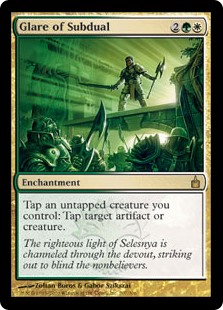Among the many axioms about battlefield tactics, one of the most useful (and obvious) is upsetting expectations. That is, the less predictable you are to your opponent, the better your chances at victory. If your enemy knows what you’re going to do, they’re going to be better prepared to stop you, and life becomes a lot lot harder. This holds to be just as true with Magic as with anything else.
Say, for instance, you have a massive creature with Trample sitting on your battlefield. By its very nature, this creature wants to attack. It desires to clock your opponent for as much damage as possible. If it has to literally go through a defending creature in the process, well, that’s fine too. That is its purpose, its goal, its desire. You know this too. After all, you put that creature in your deck. You’re the one casting it to the battlefield. You’re aware of its innate potential and what you’re supposed to do with it.
The thing is, so does your opponent.
Once they see your behemoth hit the board, it’s very apparent what you plan to do with it. The mystery becomes not what the creature’s purpose is – it’s what your opponent will do to stop it. While the challenge in those situations shifts to the defender, so too does the element of surprise. How will they react? Will they?
Compare that against a moderately sized creature with an activated ability. In those cases, the element of the unknown remains with you much longer. You can attack with that creature, sure, but maybe you benefit just as much – or more – by holding off to use its ability instead. This creates a more complicated game state (which is why you see less of this than in decades past), but it also makes more dynamic decision-making between yourself and your enemies. It gives creatures more agency than solely for ETB effects or to be pure agents of attacking, which in turn only helps to keep your opponent guessing. This opens up new avenues for battlefield strategy and makes creatures far less binary.
That’s all well and good if most of your creatures have some sort of activation. But…how do you provide that extra layer of depth if most of your creatures are full of static abilities – or none at all? Well, one answer happens to be this week’s card.
Today we have: Glare of Subdual

Name: Glare of Subdual
Edition: Ravnica / Eternal Masters
Rarity: Rare
Focus: Board Control
Highlights: Glare of Subdual first appeared in Ravnica as part of the Selesnya guild, the one traditionally known for pumping out copious token creatures. With a large enough armada, token armies are easily capable of overwhelming your opponent’s defenses by sheer volume. With more modest creature amounts, however, they’re usually relegated to token blockers or sacrifice fodder. Glare of Subdual helps shift the power back in those cases in your favor.
On the surface, Glare of Subdual is a slightly weaker color-shifted version of Opposition. Yet the lack of being able to tap down lands – less useful in settings like EDH – is well worth the tradeoff for putting this lockdown ability into the two colors best at producing token creatures. Also known as the colors best capable of making use of such a power.
As anyone who has been on the receiving end of either Enchantment will attest, with even a handful of creatures at the helm you’re capable of providing a highly useful defensive posture on a 1-for-1 basis. In a Commander setting this could be used to prevent specific creatures across multiple players from attacking, thereby dictating which creatures can dish out damage, or it can be utilized to stymie a particular player from being able to attack at all. This can be done strategically, but it’s just as effective from a political angle as well, aiding or hampering other players as needed.
Of course, Glare of Subdual’s ability can also be used offensively to tap down creatures before you launch an attack, ensuring you’ll be dealing maximum damage. So long as you have enough creatures, it’s possible to hurt your opponent with even smaller creatures without having to sacrifice half of your attackers to a firing squad of blockers.
Yes, with a multitude of possibilities, this card is capable of turning even a boring handful of creatures into a versatile amount of board control. It’ll give you plenty of battlefield options beyond merely attacking or blocking, which in turn will definitely keep your opponent guessing what you’ll do with them next. And the longer you can remain unpredictable, the better off you are.
Keep an eye out for us to be regularly featuring other more accessible-but-worth-it Commander cards going forward. In the meantime, we’ll keep the light on for you.
![]()
You can discuss this article over on our social media!
Do you have a particular Commander card to suggest for us to shine a future Spotlight on? You can send suggestions to ryan@cardboardrepublic.com
